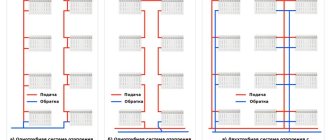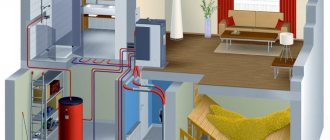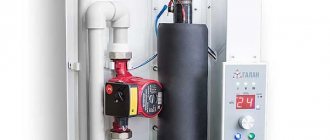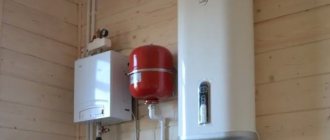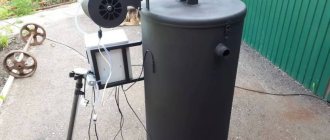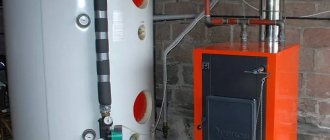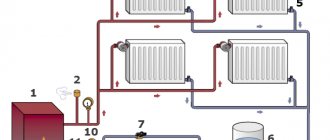Creating heating in your own home implies the use of automation as a mandatory element. You won’t constantly sit in the boiler room and manually monitor the operation of the boiler and other operating parameters of the system itself. And it is better to ensure comfortable conditions in the house not by opening the windows, although no one has canceled ventilation in the rooms, but by setting the desired temperature. These are the tasks that the automation of heating systems performs.
Components of a heating control system
What needs to be automated?
Considering how a house is heated, it should be noted that the operation of the automatic heating system should cover at least the following components:
- heating boiler operation;
- providing comfortable living conditions;
- saving fuel and operating equipment in a gentle manner.
As a rule, when choosing a heating boiler, we already partially determine what kind of heating automation will be used. The fact is that manufacturers of high-quality similar equipment include a heating control unit in the design.
Its task is to create a safe operating mode for the boiler, for which additional sensors are used. As a rule, such a heating system controller monitors safety and provides:
- protection against coolant overheating;
- protection against increases and decreases in pressure in the system;
- control of boiler filling with water;
- control of gas pressure in the line (for gas heating);
- exhaust gas pressure control.
Some of these functions can be installed at the customer’s request (optional), but automatic heating control, at least the operation of the boiler, will be complete with this approach.
The operation of a modern boiler is controlled using a special panel
Features of organizing a heating system in a smart home
How to assemble a smart home system, connect heating and remote control, as well as other complexes (ventilation, air conditioning, lighting) is a question that should be resolved at the stage of planning the house and the system as a whole. It all depends on the selected control module, its capabilities and the number of relays.
For example, if a module with 12 channels is installed (for example, MP716 Laurent-112), then you can connect up to 12 points for subsequent control, and then the “smart home” plan will be radically different from a system with 6 channels.
Thus, first you need to buy a controller, and then relays, sensors and other components of a “smart home”. This is also due to the fact that different units may have different protocols (Z-Wave is different from ZigBee, and so on), so you need to select not components for the controller, but vice versa.
Recently, Xiaomi has been supplying its own controllers to the market.
After purchasing the control unit, you can plan the heating system. The centralized local controller must have a direct connection to all zone relays (if used) or to each of the heating elements. If only radiators and a boiler are connected to the smart home, they can be controlled using thermostats or other sensors installed at the outlet of the radiators.
How to form a network of devices and relays, you need to understand the layouts individually - but it is important to follow the logic and take into account the peculiarities of the local power grid.
About automatic control of the heating system
When considering the automation of heating systems, it should be borne in mind that heating can be controlled by temperature:
GSM module for heating boilers: purpose and operation of the remote controller
- coolant;
- air in the house;
- outside air, weather dependent.
Control systems based on coolant temperature control operate regardless of current conditions. The consequence of this will be high inertia of the entire process, low efficiency and wastefulness. The best results are shown by an automatic heating system that works to maintain the set temperature in the house.
Elements of a weather-compensated heating control system
Weather-dependent regulation is considered the most progressive and effective, since it allows you to quickly respond to changing environmental conditions. However, conventional means that monitor and control the heating system can ensure its fairly efficient operation.
Beautiful and comfortable
A lazy bed is a completely new approach to gardening, which will allow seedlings to grow on their own and produce several times more yield. It is based on a rule that states that digging and weeding the soil is prohibited, except for its preparation and planting itself. Even though constant weeding can remove weeds and fluff up the soil, sooner or later it will dry out and will not be able to provide sufficient moisture for crops.
Stone fences are an easy way to build a foundation for a garden bed on uneven terrain.
Compact beds in urban areas
Raised beds with trellises on a gravel plot
How it works
It should be noted here that automation for heating a private home can be built using a variety of devices, operating both autonomously and under the control of centralized systems.
Control using a heating boiler
With this approach, all heating control comes down to setting the temperature of the coolant on the boiler. In this case, the automation built into it begins to work; for heating that works in this way, control on the boiler is quite sufficient. It will maintain the required coolant temperature regardless of its value in the premises.
More details in the article - automation for a heating boiler.
Thermostatic valve
Perhaps this is the simplest automatic heating temperature controller. It is placed on each radiator, and on it (on its head) you can set the desired value. In cases where it becomes too hot, the regulator operates and cuts off the flow of coolant into the battery. When the temperature drops below the set value, the valve opens and water begins to flow into the radiator, heating the room.
Automation for gas heating boilers
Thermostatic valve
Such automation of heating of a private house works without reference to the temperature of the coolant, in fact being universal and independent of the type of boiler used (gas, solid fuel, liquid, etc.).
The disadvantage of this approach is the lack of savings due to the inability to control the boiler and fuel consumption.
Room temperature controller
In this case, a special temperature controller is installed in the room - essentially a heating controller. It changes the heating of the coolant (turning on or off the burners, adjusting the water supply, etc.), providing the desired mode.
Room temperature controller
In fact, in this case, the control is completely electronic; the heating of the house operates according to commands from a special center and can implement any given operating mode. If such a control and regulation structure is equipped with remote communication units and a GSM module, an automated heating system control unit with remote access will be formed.
Automation for pump
Regulates the operation of the system, controlling many functions, such as, for example, pressure, water distribution.
For normal operation, the following components are required: a manifold that provides water supply, a relay that controls the pump, a pressure gauge that measures pressure, a dry-running sensor that prevents the device from overheating if the water runs out.
All automation responsible for the pump is divided into several models, based on the time of creation:
First generation automation;
The first simplest water supply design. Used to solve simple problems when it is necessary to provide a room with a source of water. It consists of three components: a dry running sensor, a hydraulic accumulator that performs the task of accumulating water and contains a membrane, and a relay that controls water pressure. It usually does not cause any difficulties during installation, since the system completely eliminates complex electrical circuits. The mechanism is also extremely easy: the order is cyclical—when the water is completely filled, the pump turns off, then the cycle repeats.
Second generation automation
The sample differs from the previous one in that sensors have been added to the control to monitor the operation. As a result, a hydraulic accumulator is not necessary, since its function is performed by sensors. The second generation automation is not in great demand, as it is similar to the first, but is much more expensive.
Third generation automation
It is a more worthy version of its predecessors, and costs more accordingly. The unit stands out for its greatest reliability, efficiency, improved safety program, and most importantly, maximum accuracy of the device.
To maintain the device in automatic mode, a relay is installed. The mechanism is simple: when the water pressure decreases, the relay starts the system, and similarly, when the pressure increases, it stops.
Thermostat to turn the pump on or off
The most common type of automation for a pump in home heating. Mechanism: first, information is collected from the sensor, then the indicators are compared, the operation of the pump depends on this. For example, if the owner sets the mode to +60 and the hysteresis to +5, then the water must be +65 for the system to start, and for it to stop, the temperature must be +55.
Combined control option
It is worth noting that the joint operation of the regulator and thermostatic valve creates optimal conditions for the system to operate. The heating control controller will ensure economical fuel consumption and air temperature control, and the valve will allow you to maintain the desired mode in each room.
To create optimal parameters for the operation of a heating system, it needs automation tools that not only maintain comfortable conditions, but also provide significant savings in the cost of heating the house.
The fence is my highlight
It’s not without reason that they say that the original fence is the highlight of any country building. Show the taste and sense of style of the owner, make the site bright against the background of other buildings; a fence can do all this if it is designed in an original way.
The pointed ends of a wooden fence can be turned into a set of multi-colored pencils. You just need to paint the tree in different colors.
The trellis in the garden will change its appearance after applying paints and stencil designs to it.
Plastic bottles can be used to create a variety of animals, birds and trees. You only need to repaint them in the appropriate color.
Do not throw away corks, because with their help you can create unimaginable patterns and paintings. At the end the work should be painted.
Read: Weaving from newspaper tubes for beginners: photos, blanks, weaving methods, secrets of successful weaving
The log can be turned into a bird feeder.
Do you have a lot of free space on your property? Make a pond. For this:
- dig a hole of any size;
- seal the surface;
- make sure that the ground does not absorb water;
- decorate the pond with natural stones.
When choosing stones, make sure they match the size of the pond. It is not practical to decorate a large pond with tiny stones. In general, creating a lake is not such a difficult process. The time and effort spent will not go to waste.
Other devices for temperature control
Table 2. Types of temperature controllers
Thermostat imageVarietyDescription
| Built-in thermostats with water temperature sensor | Capillary thermostats are used to control the operation of hot water boilers |
| Mechanical thermostats | Mechanical temperature controllers are used to maintain the temperature regime, which is set manually using a roller |
| Wired regulators | Thermostats are a simple design that is connected to the electrical network along with the boiler equipment |
| Wireless thermostats | The equipment does not require connection to the electrical network and operates at a certain distance from the coolant |
Principle of operation
Some devices simply help maintain the required temperature and save money on it. More complex gadgets are given special algorithms of action. For example, they can automatically change the temperature regime, focusing on the owner’s preferences, day of the week and time of day (at night the temperature should be lower for good sleep, in the morning it should be higher to make it easier to get up for work/school).
Also, the boiler can turn on/off depending on the temperature outside, in the house or in a specific room. It is possible to turn it off remotely to save money and turn it on in advance, before coming into the house. This is especially convenient for large houses with an area of 150-200 square meters.
It is enough to configure the system via a computer or a special application on a smartphone.
Where to buy equipment
You can purchase smart heating equipment either in a specialized store or online in an online store. In the second case, the budget option for purchasing products on the Aliexpress website deserves special attention. For some lamps there is an option for shipment from a warehouse in the Russian Federation; they can be received as quickly as possible; to do this, when ordering, select “Delivery from the Russian Federation”
| Heating controller ZONT SMART 2.0 | Smart thermostat AVATTO Tuya with Wi-Fi | Smart radiator drive TRV ZigBee3.0 |
| Smart water heating controller | MoesHouse ZigBee Thermostat | Controller for gas boiler TUYA |
